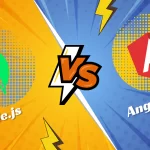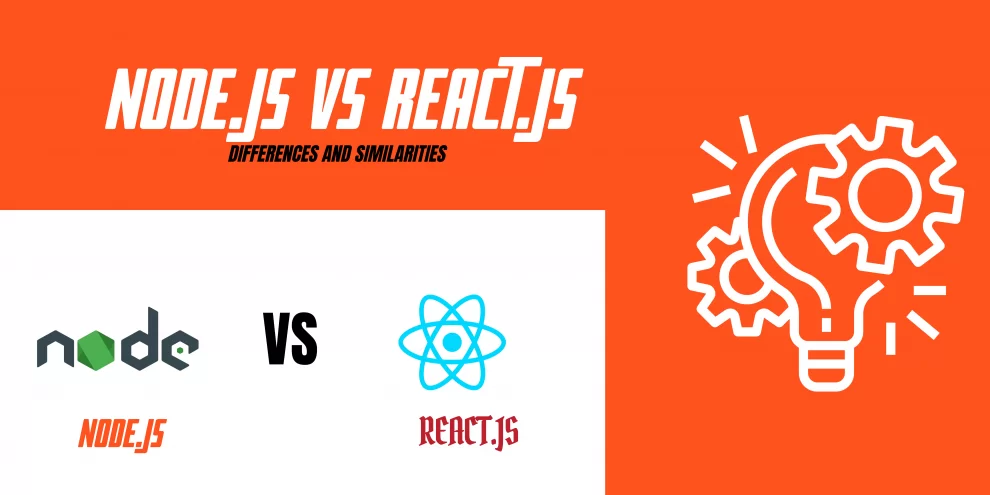Welcome to the dynamic realm of web development, where the intersection of technologies often leads to exciting innovations. In this exploration, we set our sights on two influential players: Node.js and React.js. The essence of Comparing Node.js and React.js lies in deciphering the distinctive roles each technology plays in the ever-evolving landscape of web development.
Node.js, a runtime environment, and React.js, a JavaScript library for building user interfaces, command attention with their unique attributes. As we embark on this journey, we’ll unravel the intricacies that set them apart and delve into their respective strengths. Join us as we navigate the exciting terrain of server-side scripting, client-side interface development, and the seamless integration of these technologies into modern web applications. Let’s decipher the nuances, advantages, and applications of Node.js and React.js, ultimately empowering you to make informed decisions in your web development endeavors.
The Core Purpose
At the heart of understanding and Comparing Node.js and React.js lies a fundamental exploration of their core purposes. Node.js, a powerhouse in server-side scripting, serves as a runtime environment for executing JavaScript code on servers. On the flip side, React.js emerges as a JavaScript library uniquely tailored for crafting interactive and dynamic user interfaces on the client side.
In essence, Node.js steps into the backend arena, facilitating the execution of server-side tasks and handling concurrent connections efficiently. Its asynchronous, non-blocking I/O model distinguishes it as a formidable choice for scalable network applications and real-time systems.
Conversely, React.js positions itself on the frontend, elevating the art of building user interfaces to new heights. Its core purpose revolves around simplifying the creation of UI components, promoting a modular and reusable approach to frontend development. By adopting a component-based architecture, React.js enables developers to construct sophisticated user interfaces with ease.
In the realm of Comparing Node.js and React.js, appreciating their core purposes unveils the dichotomy between backend server scripting and frontend user interface design. Together, they form a powerful duo, orchestrating a seamless symphony that brings life to modern web applications.
Architecture and Design
As we delve into the realm of Comparing Node.js and React.js, an essential facet to explore is their distinct architectures and design principles.
Node.js Architecture:
Node.js boasts a scalable and event-driven architecture, positioning it as a robust choice for handling concurrent connections. Its event loop mechanism allows for asynchronous, non-blocking execution, enabling the server to efficiently manage multiple tasks simultaneously. This architecture aligns well with scenarios where real-time updates and responsiveness are paramount, making Node.js a preferred option for building scalable network applications.React.js Design:
On the other side of the spectrum, React.js introduces a component-based architecture that revolutionizes the way developers approach frontend design. The core idea revolves around breaking down the user interface into modular and reusable components. This design paradigm not only enhances maintainability but also fosters a more efficient development process. Each React component encapsulates its logic and styling, promoting a structured and organized approach to building dynamic user interfaces.Harmonizing Backend and Frontend:
In the grand scheme of web development, the synergy between Node.js and React.js is noteworthy. While Node.js efficiently manages the server-side tasks with its event-driven architecture, React.js takes the baton on the client-side, orchestrating a harmonious blend of components to create a responsive and interactive user experience. This dichotomy in architecture showcases how these technologies seamlessly integrate to deliver a comprehensive solution for modern web applications.Advantages of Node.js and React.js Architecture:
Node.js Scalability and efficiency in handling concurrent connections. React.js Modularity, reusability, and a structured approach to building user interfaces.In Practice:
Understanding the architecture and design of Node.js and React.js empowers developers to make informed decisions based on the specific requirements of their projects. Whether orchestrating backend operations or crafting intricate user interfaces, the architecture and design principles of these technologies play a pivotal role in shaping the development landscape. Join us as we continue to unravel the intricate tapestry of Comparing Node.js and React.js, gaining insights that transcend the surface of web development.
Also Read: Integrating MySQL with Node.js Applications
Performance and Speed
Node.js Performance:
Node.js shines in performance, leveraging a non-blocking, asynchronous I/O model for optimal speed in server-side operations.React.js Speed:
React.js optimizes UI performance, ensuring seamless rendering and a responsive user experience for dynamic, feature-rich interfaces.Performance Metrics:
Node.js excels in handling concurrent tasks efficiently, while React.js prioritizes real-time updates and responsiveness in user interface interactions.Synergy in Speed:
The synergy between Node.js and React.js is evident—Node.js speeds up server-side tasks, while React.js enhances client-side UI responsiveness.Developer Impact:
Understanding the performance nuances of Node.js and React.js equips developers to create fast, responsive applications tailored to user expectations.Continuous Optimization:
Both technologies, with active communities, undergo continuous optimization, ensuring they remain at the forefront of efficient web development practices.
In this exploration of Comparing Node.js and React.js, speed becomes a critical dimension shaping the user experience and application responsiveness. Stay tuned as we navigate deeper into the intricacies of these technologies.
Ecosystem and Dependencies
Node.js Ecosystem:
Node.js boasts an expansive ecosystem, powered by the Node Package Manager (npm). This vast repository of packages provides developers with a rich set of libraries and modules, facilitating streamlined development and ensuring the scalability of Node.js applications.React.js Dependencies:
In the React.js ecosystem, the focus is on a component-centric approach. While it may not have the sheer volume of packages seen in Node.js, React.js thrives on a robust ecosystem that revolves around building reusable UI components. This approach enhances the maintainability and reusability of frontend code.Node.js Versatility:
The versatility of Node.js is evident in its ability to seamlessly integrate with various databases, making it a go-to choice for backend development. This compatibility extends the reach of Node.js applications, allowing developers to craft solutions tailored to diverse use cases.React.js Component Reusability:
React.js shines in its commitment to component reusability. The ecosystem supports the creation of modular UI components, each encapsulating specific functionality. This not only simplifies development but also ensures a consistent and efficient approach to building dynamic user interfaces.Developer Productivity:
Both Node.js and React.js ecosystems contribute significantly to developer productivity. Node.js provides a vast selection of tools and packages, streamlining backend development, while React.js enhances frontend development with a focus on component-based architecture and UI reusability.Balancing Act:
In the journey of Comparing Node.js and React.js, understanding the ecosystems and dependencies is pivotal. Node.js excels in backend versatility, while React.js elevates frontend development through a commitment to component reusability. Together, they strike a balance that empowers developers to create comprehensive, scalable, and efficient web applications.Future-Proofing:
The constant evolution of both ecosystems, driven by active communities, ensures that Node.js and React.js remain at the forefront of web development trends. This forward-looking approach future-proofs applications, promising sustained support and adaptability in the ever-changing tech landscape.
Community Support
Node.js Community:
Node.js thrives on a vibrant and engaged community of developers worldwide. This active support network plays a pivotal role in the continuous evolution and improvement of Node.js. Developers contribute through forums, discussions, and collaborative projects, fostering an environment of shared knowledge and expertise.React.js Community:
Similarly, React.js boasts a robust and enthusiastic community. With a shared passion for frontend development, React.js developers actively participate in forums, contribute to open-source projects, and share best practices. This community-driven ethos enhances the library’s growth and ensures that React.js remains a cutting-edge solution for building user interfaces.Collaboration and Knowledge Sharing:
The collaborative spirit within both Node.js and React.js communities is evident. Developers come together to address challenges, share insights, and contribute to the enhancement of these technologies. This collaborative ethos not only accelerates the learning curve for newcomers but also ensures a rapid response to emerging trends and challenges in web development.Learning Resources:
The wealth of learning resources within these communities is invaluable. From documentation and tutorials to blog posts and video content, developers have access to a vast pool of knowledge. This abundance of resources facilitates skill development, making it easier for developers to stay informed and proficient in Node.js and React.js.Impact on Development:
For developers, community support is more than just a network; it’s a lifeline. The support and collaboration within these communities have a direct impact on the ease of troubleshooting, the availability of resources, and the overall experience of working with Node.js and React.js.Future Growth:
As we navigate the landscape of Comparing Node.js and React.js, the strong community support for both technologies underscores their enduring relevance. The commitment of developers to shared growth ensures that Node.js and React.js will continue to evolve, adapt, and meet the challenges of tomorrow’s web development landscape. Stay tuned as we unravel more insights into these dynamic technologies.
Integration with Other Technologies
Node.js Integration:
Node.js stands out for its seamless integration with various databases and third-party services. Its asynchronous nature facilitates efficient handling of concurrent tasks, making it an ideal backend choice for applications requiring integration with diverse technologies. Whether connecting to databases like MongoDB or interfacing with APIs, Node.js provides a versatile foundation.React.js in Tech Stacks:
React.js excels in frontend integration within diverse tech stacks. Its component-based architecture promotes modularity, enabling smooth collaboration with other frontend libraries and frameworks. React.js seamlessly integrates with tools like Redux for state management and GraphQL for efficient data fetching, enhancing the overall development experience.Full Stack Harmony:
The harmony between Node.js and React.js becomes evident in full-stack development. Node.js handles server-side operations and integrates well with databases, while React.js crafts dynamic user interfaces on the client side. This synergistic integration forms a powerful alliance, facilitating the creation of comprehensive and efficient web applications.Real-time Applications:
Node.js, known for its real-time capabilities, integrates seamlessly into applications requiring live updates and instantaneous responses. Whether it’s a chat application, a collaborative tool, or a live-streaming platform, Node.js ensures a smooth flow of real-time data, enhancing the user experience.Microservices Architecture:
Both Node.js and React.js complement the microservices architecture trend. Node.js excels in building lightweight, scalable microservices on the backend, while React.js facilitates the development of independent, modular UI components on the frontend. This combination promotes a microservices approach, enhancing scalability and maintainability.Developer Flexibility:
The flexibility afforded by the integration capabilities of Node.js and React.js empowers developers to choose technologies that best suit their project requirements. Whether crafting a monolithic architecture or adopting a microservices approach, the integration prowess of these technologies adapts to diverse development scenarios.Future-proofing Integrations:
In the ever-evolving landscape of web development, the adaptability and compatibility of Node.js and React.js with emerging technologies contribute to future-proofing. This ensures that applications developed with these technologies can seamlessly integrate with the technologies of tomorrow, fostering longevity and relevance. As we delve deeper into the comparison of Node.js and React.js, the integration landscape unfolds, showcasing the versatility and collaborative potential of these powerful technologies.
Also Read: How To Set Up a GraphQL API Server in Node.js
Popularity and Adoption
Node.js Popularity:
Node.js has soared in popularity, becoming a cornerstone in web development. Its efficiency in handling concurrent tasks and facilitating real-time applications has led to widespread adoption. Node.js is favored by large-scale enterprises and startups alike, contributing to its robust community and continuous growth.React.js Adoption:
React.js has witnessed remarkable adoption, emerging as a dominant force in frontend development. Its declarative and component-based approach resonates with developers, making it a preferred choice for building user interfaces. React.js is backed by Facebook and adopted by major tech companies, solidifying its popularity and ensuring ongoing support.Synergy in Tech Stacks:
The synergy between Node.js and React.js contributes to their combined popularity. Full-stack development with Node.js on the backend and React.js on the frontend has become a prevalent tech stack choice. This harmony allows developers to leverage the strengths of both technologies, creating scalable and performant applications.Job Market Trends:
The job market reflects the popularity of Node.js and React.js, with a high demand for professionals skilled in these technologies. Companies actively seek developers proficient in Node.js for backend tasks and React.js for frontend development, making expertise in these technologies a valuable asset in the job market.Industry Preference:
Node.js and React.js have garnered favor across various industries. From e-commerce to social media and from fintech to entertainment, these technologies have found applications in diverse sectors. Their adaptability and efficiency contribute to their universal appeal, making them go-to choices for innovative projects.Community Momentum:
The strong and active communities surrounding Node.js and React.js play a crucial role in sustaining their popularity. Regular updates, collaborative projects, and a wealth of learning resources keep developers engaged and foster an environment of continuous improvement.Staying Ahead:
In the realm of Comparing Node.js and React.js, understanding their popularity and adoption trends provides valuable insights for developers and businesses. Staying ahead in the tech landscape involves harnessing the strengths of these widely embraced technologies, ensuring the creation of modern, scalable, and sought-after web applications. As we navigate deeper into the comparison, the popularity of Node.js and React.js continues to shape the future of web development.
Conclusion
In the intricate tapestry of web development, the comparison between Node.js and React.js reveals a symbiotic relationship that empowers developers to create cutting-edge applications. Node.js emerges as a stalwart on the server side, with its event-driven architecture and efficiency in handling concurrent tasks. React.js, on the other hand, takes the lead in crafting dynamic and modular user interfaces, redefining frontend development with its component-based design.
The performance harmony achieved by Node.js and React.js sets a high standard, with Node.js optimizing server-side operations and React.js ensuring a responsive user experience on the client side. Their ecosystems, though distinct, complement each other, fostering a seamless integration that adapts to diverse tech stacks. The robust communities surrounding these technologies contribute to their enduring popularity, driving continuous innovation and support.
As we conclude this exploration, the versatility, performance, ecosystem brilliance, and community vibrancy of Node.js and React.js stand as a testament to their impact on modern web development. Their universal appeal, adaptability, and collaborative potential position them not only as current favorites but also as future-proof choices in a dynamic and ever-evolving tech landscape. The journey of Comparing Node.js and React.js is a voyage of discovery, empowering developers to navigate the complexities of web development with creativity, efficiency, and a forward-looking perspective.















